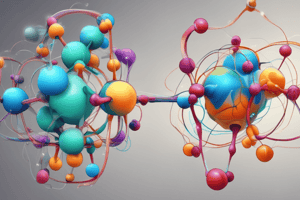Podcast
Questions and Answers
Which type of bond involves sharing valence electrons among metal atoms without being attached to any specific central atom?
Which type of bond involves sharing valence electrons among metal atoms without being attached to any specific central atom?
- Covalent bond
- Hydrogen bond
- Ionic bond
- Metallic bond (correct)
In which type of bond are the positive nuclei of metal atoms surrounded by a sea of delocalized electrons?
In which type of bond are the positive nuclei of metal atoms surrounded by a sea of delocalized electrons?
- Ionic bond
- Metallic bond (correct)
- Van der Waals bond
- Covalent bond
Which type of bond often exhibits complex structures and is crucial for biochemistry and biological systems?
Which type of bond often exhibits complex structures and is crucial for biochemistry and biological systems?
- Hydrogen bond
- Covalent bond (correct)
- Metallic bond
- Van der Waals bond
What type of bond requires learning about various atomic interactions such as ionic, covalent, and metallic bonds?
What type of bond requires learning about various atomic interactions such as ionic, covalent, and metallic bonds?
Which bond enables chemists to predict and manipulate the behavior of materials based on the kinds of bonds present?
Which bond enables chemists to predict and manipulate the behavior of materials based on the kinds of bonds present?
What type of bond occurs when a metal loses an electron and a non-metal gains an electron?
What type of bond occurs when a metal loses an electron and a non-metal gains an electron?
Which atom in an ionic bond typically loses an electron?
Which atom in an ionic bond typically loses an electron?
In a covalent bond, how are electrons shared between atoms?
In a covalent bond, how are electrons shared between atoms?
What type of bond involves the sharing of electron pairs between atoms?
What type of bond involves the sharing of electron pairs between atoms?
Which type of bond is exemplified by the formation of carbon dioxide (CO2)?
Which type of bond is exemplified by the formation of carbon dioxide (CO2)?
What type of bond forms a crystalline solid like table salt (sodium chloride)?
What type of bond forms a crystalline solid like table salt (sodium chloride)?
Flashcards are hidden until you start studying
Study Notes
Chemistry: Understanding Chemical Bonding
Chemical bonding is one of the fundamental concepts in chemistry, describing how atoms interact with each other to form molecules and compounds. This interaction occurs between the electrons in the outermost shells of two atoms. In general, there are three types of chemical bonds: ionic, covalent, and metallic. Here we explore each type in more detail.
Ionic Bonds
Ionic bonds occur when a metal loses an electron from its valence shell, creating a positively charged ion called a cation; while a non-metal gains an electron, becoming negatively charged ions known as anions. These oppositely charged ions attract one another due to their opposite charges, forming an ionic compound. For example, sodium chloride forms because sodium has only one electron in its valence shell and can lose it, leaving behind a positive charge; chlorine needs one more electron to complete its valence shell, so it takes away an electron from sodium, resulting in a negative charge. Because they have opposite charges, these ions attract and form a crystalline solid like table salt.
Covalent Bonds
A covalent bond occurs when a pair of electrons is shared by two atoms, allowing both to fill up their empty spaces in their outermost energy levels. Carbon dioxide CO2 exemplifies this kind of bond where carbon shares four pairs of electrons with each oxygen atom, leading to the formation of a stable structure. Additionally, some organic compounds such as hydrocarbons contain covalent bonds and often exhibit complex structures, making them essential to understanding life processes, especially those related to biochemistry and biological systems.
Metallic Bonds
Metals tend to share their valence electrons among themselves without being attached to any specific central atom, which results in strong interactions throughout the entire crystal lattice. An example of this type of bond is found in metals like iron or copper where the positive nuclei of the metal atoms are surrounded by a sea of delocalized electrons.
In summary, understanding chemical bonding requires learning various types of atomic interactions — ionic, covalent, and metallic. Each type offers different characteristics, mechanisms, and properties, enabling chemists to predict and manipulate the behavior of materials based on the kinds of bonds present.
Studying That Suits You
Use AI to generate personalized quizzes and flashcards to suit your learning preferences.




